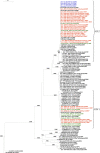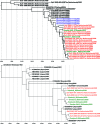Epidemiology and genotype analysis of emerging sapovirus-associated infections across Europe
- PMID: 20392905
- PMCID: PMC2884469
- DOI: 10.1128/JCM.02427-09
Epidemiology and genotype analysis of emerging sapovirus-associated infections across Europe
Abstract
Sapoviruses (SaVs) belong to the Caliciviridae family and can cause gastroenteritis in humans and swine. Despite extensive testing, human sapoviruses have been found only in sporadic cases and in one mixed outbreak in children between 1994 and 2007 in the Netherlands. Here we describe a change in sapovirus epidemiology in the Netherlands resulting in sapovirus outbreaks and infections in adults. From November 2007 to January 2009, 478 outbreaks of acute gastroenteritis were reported to the National Institute for Public Health and the Environment in the Netherlands as a part of ongoing surveillance. Sapoviruses were found to be the most likely cause of 19 outbreaks (4%). During the same 2-year period, sapovirus infections were reported in Sweden, Slovenia, and Hungary. In the Netherlands, further characterization of outbreak strains showed that 12 (63%) sapovirus outbreaks were caused by genotype I.2 viruses. Most patients were adults older than 60 years (range, 1 to 100 years). Phylogenetic analysis using all presently available SaV sequences showed high homology between genotype I.2 strains detected in different geographical regions (Sweden, Slovenia, Taiwan, Japan, and Russia) since 2007. These first reported outbreaks of sapovirus infections in adults in the Netherlands were remarkable. Detection of identical genotypes in many samples might suggest that these viruses have the same origin, and since the infection is spreading fast, the prevalence of sapovirus infection may be increasing. The incidence of sapovirus infections in these countries suggests that a substantial part of Europe is affected by this virus.
Figures





Similar articles
-
Phylogenetic analysis of sapovirus detected from an outbreak of acute gastroenteritis on Ishigaki Island (Okinawa Prefecture, Japan) in 2012.Jpn J Infect Dis. 2014;67(2):141-3. doi: 10.7883/yoken.67.141. Jpn J Infect Dis. 2014. PMID: 24647263 No abstract available.
-
Incidence, diversity, and molecular epidemiology of sapoviruses in swine across Europe.J Clin Microbiol. 2010 Feb;48(2):363-8. doi: 10.1128/JCM.01279-09. Epub 2009 Nov 25. J Clin Microbiol. 2010. PMID: 19940055 Free PMC article.
-
Epidemiology and genotype analysis of sapovirus associated with gastroenteritis outbreaks in Alberta, Canada: 2004-2007.J Infect Dis. 2009 Feb 15;199(4):547-51. doi: 10.1086/596210. J Infect Dis. 2009. PMID: 19099483
-
Molecular epidemiology and genotype distributions of noroviruses and sapoviruses in Thailand 2000-2016: A review.J Med Virol. 2018 Apr;90(4):617-624. doi: 10.1002/jmv.25019. Epub 2018 Jan 23. J Med Virol. 2018. PMID: 29315631 Review.
-
Molecular epidemiology of human enteric caliciviruses in The Netherlands.Novartis Found Symp. 2001;238:197-214; discussion 214-8. doi: 10.1002/0470846534.ch12. Novartis Found Symp. 2001. PMID: 11444027 Review.
Cited by
-
The analysis of the genotype of Sapovirus outbreaks in Zhejiang Province.Virol J. 2023 Nov 16;20(1):268. doi: 10.1186/s12985-023-02202-z. Virol J. 2023. PMID: 37974193 Free PMC article.
-
Sapovirus infection as another cause of persistent viral diarrhea: case series and review of the literature.Eur J Clin Microbiol Infect Dis. 2024 Jan;43(1):55-59. doi: 10.1007/s10096-023-04695-6. Epub 2023 Nov 4. Eur J Clin Microbiol Infect Dis. 2024. PMID: 37924444 Review.
-
Atypical Viral Infections in Gastroenterology.Diseases. 2022 Oct 15;10(4):87. doi: 10.3390/diseases10040087. Diseases. 2022. PMID: 36278586 Free PMC article. Review.
-
From a case-control survey to a diagnostic viral gastroenteritis panel for testing of general practitioners' patients.PLoS One. 2021 Nov 3;16(11):e0258680. doi: 10.1371/journal.pone.0258680. eCollection 2021. PLoS One. 2021. PMID: 34731182 Free PMC article.
-
Molecular Epidemiology of Human Sapovirus among Children with Acute Gastroenteritis in Western Canada.J Clin Microbiol. 2021 Sep 20;59(10):e0098621. doi: 10.1128/JCM.00986-21. Epub 2021 Jul 21. J Clin Microbiol. 2021. PMID: 34288727 Free PMC article.
References
-
- Chiba, S., Y. Sakuma, R. Kogasaka, M. Akihara, K. Horino, T. Nakao, and S. Fukui. 1979. An outbreak of gastroenteritis associated with calicivirus in an infant home. J. Med. Virol. 4:249-254. - PubMed
-
- Duizer, E., A. Pielaat, H. Vennema, A. Kroneman, and M. Koopmans. 2007. Probabilities in norovirus outbreak diagnosis. J. Clin. Virol. 40:38-42. - PubMed
-
- Farkas, T., W. M. Zhong, Y. Jing, P. W. Huang, S. M. Espinosa, N. Martinez, A. L. Morrow, G. M. Ruiz-Palacios, L. K. Pickering, and X. Jiang. 2004. Genetic diversity among sapoviruses. Arch. Virol. 149:1309-1323. - PubMed
-
- Gallimore, C. I., M. Iturriza-Gomara, D. Lewis, D. Cubitt, H. Cotterill, and J. J. Gray. 2006. Characterization of sapoviruses collected in the United Kingdom from 1989 to 2004. J. Med. Virol. 78:673-682. - PubMed
Publication types
MeSH terms
Substances
LinkOut - more resources
Full Text Sources
Medical

